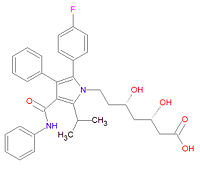Atorvastatin: Difference between revisions
imported>David E. Volk (new page) |
imported>David E. Volk (drug interactions) |
||
| Line 20: | Line 20: | ||
*Atorpic | *Atorpic | ||
*Liprimar | *Liprimar | ||
== Drug interactions == | |||
* [[Amprenavir]] can possibly increase the statin | |||
* [[Atazanavir]] increases the effect and toxicity of the statin | |||
* [[Bezafibrate]] increases the risk of [[myopathy]]/[[rhabdomyolysis]] | |||
* [[Bosentan]] could decrease atorvastatin | |||
* [[Carbamazepine]] decreases the effect of the statin | |||
* [[Colchicine]] increases the risk of rhadbomyolysis with this combination | |||
* [[Clarithromycin]] possibly increases the statin toxicity | |||
* [[Cyclosporine]] may cause [[myopathy]] and [[rhabdomyolysis]] | |||
* [[Delavirdine]] an [[NNRT inhibitor]] increases the effect and toxicity of the statin | |||
* [[Diltiazem]] increases the effect and toxicity of atorvastatin | |||
* [[Efavirenz]], an NNRT inhibitor, increases the effect and toxicity of the statin | |||
* [[Erythromycin]] possibly increases the statin toxicity | |||
* [[Fenofibrate]] Increasing risk of myopathy/rhabdomyolysis | |||
* [[Fluconazole]] Increases the risk of myopathy/rhabdomyolysis | |||
* [[Fosamprenavir]] Amprenavir can possibly increase the statin toxicity | |||
* [[Gemfibrozil]] Increases the risk of myopathy/rhabdomyolysis | |||
* [[Imatinib]] increases the effect and toxicity of atorvastatin | |||
* [[Indinavir]] increases the effect and toxicity of atorvastatin | |||
* [[Itraconazole]] Increases the risk of myopathy/rhabdomyolysis | |||
* [[Josamycin]], a macrolide, possibly increases the statin toxicity | |||
* [[Ketoconazole]] increases the risk of myopathy/rhabdomyolysis | |||
* [[Nefazodone]] increases the effect and toxicity of the statin drug | |||
* [[Nelfinavir]] increases the effect and toxicity of the statin | |||
* [[Nevirapine]], an NNRT inhibitor, increases the effect and toxicity of the statin | |||
* [[Quinupristin]] presents an increased risk of toxicity | |||
* [[Rifabutin]], a [[rifamycin]], decreases the effect of the statin drug | |||
* [[Rifampin]], a rifamycin, decreases the effect of the statin drug | |||
* [[Ritonavir]] increases the effect and toxicity of the statin | |||
* [[Saquinavir]] increases the effect and toxicity of atorvastatin | |||
* [[Tacrolimus]] increases the effect and toxicity of the statin | |||
* [[Telithromycin]] may possibly increase statin toxicity | |||
* [[Verapamil]] increases the effect and toxicity of the statin | |||
Revision as of 11:23, 24 January 2008
Atorvastatin, commonly called Lipitor, is a class II statin used to treat high cholesterol (hypercholesterolemia), prevent heart attacks and strokes, and to lessen the formation of artial plaque. It is a HMG-CoA reductase inhibitor that decreases the synthesis of mevalonate, a key chemical precursor of cholesterol. Although the structure is based on an indole ring, as are the other class II statins fluvastatin and rosuvastatin, its longer half-life and specificity for the liver makes atorvastatin a better drug for lowering LDL-cholesterol levels. The metabolites of atorvastatin, ortho- and parahydroxylated derivatives and various beta-oxidation products, are equivalent HMG-CoA reductase inhibitors. The drug should be taken with a low fat meal and alcohol and grapefruit juice should be avoided. Atorvastatin can be toxic, leading to liver problems, rhabdomyolysis and eye hemorrhages.
Its official IUPAC chemical name is (3R,5R)-7-[2-(4-fluorophenyl)-3-phenyl-4-(phenylcarbamoyl)-5-propan-2-ylpyrrol-1-yl]-3,5-dihydroxyheptanoic acid and it has chemical formula C33H35FN2O5.
brand names
- Cardyl
- Lipitor
- Sotis
- Torvast
- Tozalip
- Xavator
- Sortis
- Torvacard
- Totalip
- Tulip
- Xarator
- Atorpic
- Liprimar
Drug interactions
- Amprenavir can possibly increase the statin
- Atazanavir increases the effect and toxicity of the statin
- Bezafibrate increases the risk of myopathy/rhabdomyolysis
- Bosentan could decrease atorvastatin
- Carbamazepine decreases the effect of the statin
- Colchicine increases the risk of rhadbomyolysis with this combination
- Clarithromycin possibly increases the statin toxicity
- Cyclosporine may cause myopathy and rhabdomyolysis
- Delavirdine an NNRT inhibitor increases the effect and toxicity of the statin
- Diltiazem increases the effect and toxicity of atorvastatin
- Efavirenz, an NNRT inhibitor, increases the effect and toxicity of the statin
- Erythromycin possibly increases the statin toxicity
- Fenofibrate Increasing risk of myopathy/rhabdomyolysis
- Fluconazole Increases the risk of myopathy/rhabdomyolysis
- Fosamprenavir Amprenavir can possibly increase the statin toxicity
- Gemfibrozil Increases the risk of myopathy/rhabdomyolysis
- Imatinib increases the effect and toxicity of atorvastatin
- Indinavir increases the effect and toxicity of atorvastatin
- Itraconazole Increases the risk of myopathy/rhabdomyolysis
- Josamycin, a macrolide, possibly increases the statin toxicity
- Ketoconazole increases the risk of myopathy/rhabdomyolysis
- Nefazodone increases the effect and toxicity of the statin drug
- Nelfinavir increases the effect and toxicity of the statin
- Nevirapine, an NNRT inhibitor, increases the effect and toxicity of the statin
- Quinupristin presents an increased risk of toxicity
- Rifabutin, a rifamycin, decreases the effect of the statin drug
- Rifampin, a rifamycin, decreases the effect of the statin drug
- Ritonavir increases the effect and toxicity of the statin
- Saquinavir increases the effect and toxicity of atorvastatin
- Tacrolimus increases the effect and toxicity of the statin
- Telithromycin may possibly increase statin toxicity
- Verapamil increases the effect and toxicity of the statin
